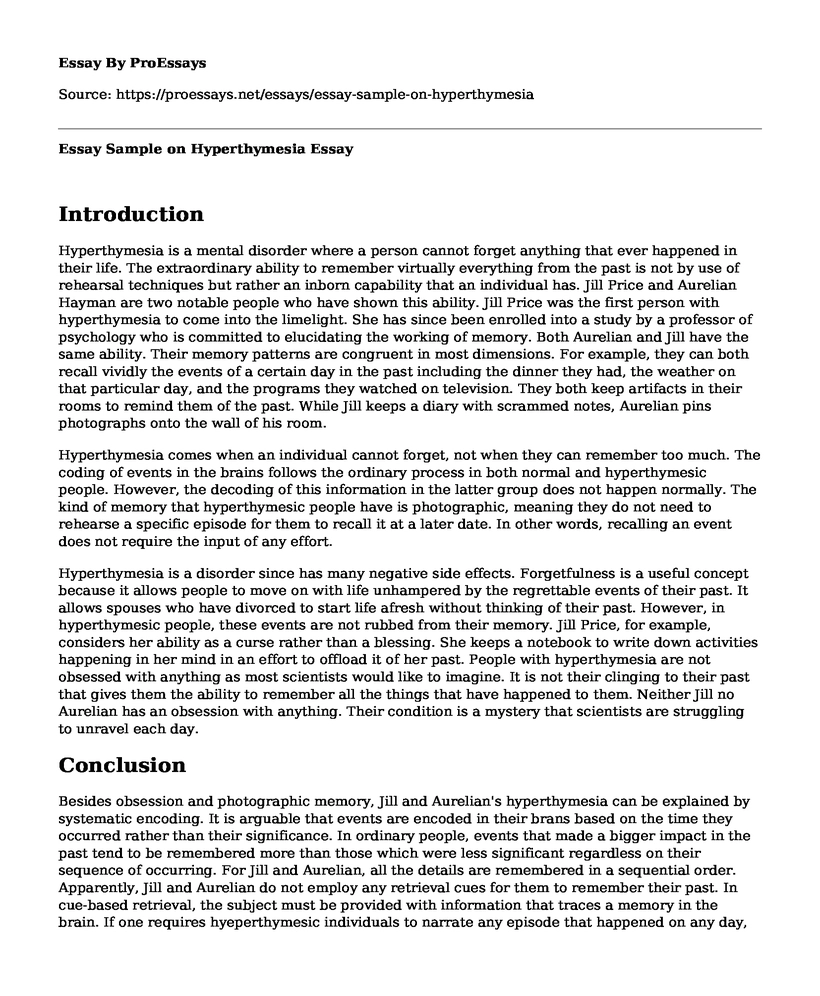Introduction
Hyperthymesia is a mental disorder where a person cannot forget anything that ever happened in their life. The extraordinary ability to remember virtually everything from the past is not by use of rehearsal techniques but rather an inborn capability that an individual has. Jill Price and Aurelian Hayman are two notable people who have shown this ability. Jill Price was the first person with hyperthymesia to come into the limelight. She has since been enrolled into a study by a professor of psychology who is committed to elucidating the working of memory. Both Aurelian and Jill have the same ability. Their memory patterns are congruent in most dimensions. For example, they can both recall vividly the events of a certain day in the past including the dinner they had, the weather on that particular day, and the programs they watched on television. They both keep artifacts in their rooms to remind them of the past. While Jill keeps a diary with scrammed notes, Aurelian pins photographs onto the wall of his room.
Hyperthymesia comes when an individual cannot forget, not when they can remember too much. The coding of events in the brains follows the ordinary process in both normal and hyperthymesic people. However, the decoding of this information in the latter group does not happen normally. The kind of memory that hyperthymesic people have is photographic, meaning they do not need to rehearse a specific episode for them to recall it at a later date. In other words, recalling an event does not require the input of any effort.
Hyperthymesia is a disorder since has many negative side effects. Forgetfulness is a useful concept because it allows people to move on with life unhampered by the regrettable events of their past. It allows spouses who have divorced to start life afresh without thinking of their past. However, in hyperthymesic people, these events are not rubbed from their memory. Jill Price, for example, considers her ability as a curse rather than a blessing. She keeps a notebook to write down activities happening in her mind in an effort to offload it of her past. People with hyperthymesia are not obsessed with anything as most scientists would like to imagine. It is not their clinging to their past that gives them the ability to remember all the things that have happened to them. Neither Jill no Aurelian has an obsession with anything. Their condition is a mystery that scientists are struggling to unravel each day.
Conclusion
Besides obsession and photographic memory, Jill and Aurelian's hyperthymesia can be explained by systematic encoding. It is arguable that events are encoded in their brans based on the time they occurred rather than their significance. In ordinary people, events that made a bigger impact in the past tend to be remembered more than those which were less significant regardless on their sequence of occurring. For Jill and Aurelian, all the details are remembered in a sequential order. Apparently, Jill and Aurelian do not employ any retrieval cues for them to remember their past. In cue-based retrieval, the subject must be provided with information that traces a memory in the brain. If one requires hyeperthymesic individuals to narrate any episode that happened on any day, they effortlessly give a full account as long the date is specified.
Cite this page
Essay Sample on Hyperthymesia. (2022, Mar 31). Retrieved from https://proessays.net/essays/essay-sample-on-hyperthymesia
If you are the original author of this essay and no longer wish to have it published on the ProEssays website, please click below to request its removal:
- Infectious Diseases and Modern-Day Stressors Paper Example
- Research Proposal on Mental Health Care
- Requirements for Addictions Professional Paper Example
- Research Paper on Police Departments & Mental Illness: Analyzing the Rise
- Cognitive Theory: Explaining the Mental Process of Learning - Essay Sample
- Paper Sample on Burnout, Turnover Intention and Saudi Arabia
- Bondage Breakers Foundation: Breaking Mental Health Disorders & Improving Lives







